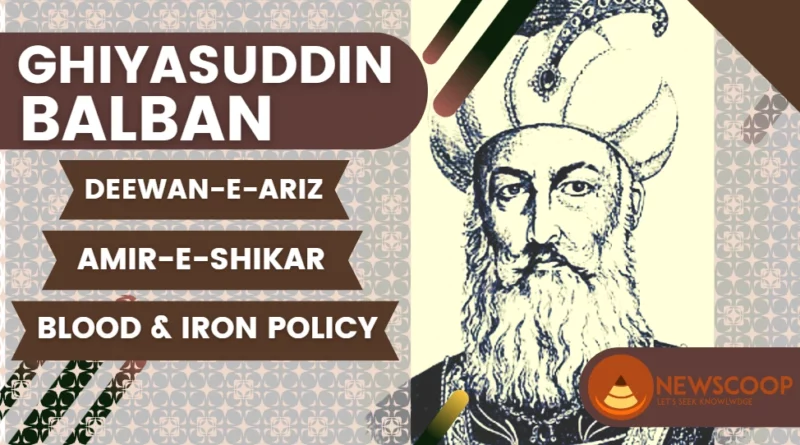Blood and Iron Policy of Balban [1266–1286]: Harsh Punishment for Stability & Control
Blood and Iron Policy of Balban [iron and blood policy of balban, balban blood and iron policy, what is blood and iron policy of Balban, a policy of blood and iron balban balban iron and blood policy]
The Blood and Iron Policy was introduced during the rule of Sultan Ghiyasuddin Balban, which lasted from 1266 to 1286. Balban was known for his use of military force and harsh measures to maintain control and stability during his rule.
Further, the “Blood and Iron Policy” was a reflection of his approach to governance, and it helped him establish a strong and centralized state.
| Policy | Blood and Iron Policy |
| Introduced by | Balban |
| Sultanate | Delhi Sultanate |
| Objective | Strong State |
What is Blood and Iron Policy?
The “Blood and Iron Policy” refers to the methods used by the Indian Sultan Balban (1266-1286) to maintain control and stability during his rule. This policy involved using military force and harsh measures to suppress internal rebellions and external invasions, as well as to centralize power and control the nobility.
Balban aimed to create a strong and centralized state, and his policy of “Blood and Iron” helped him achieve that goal. The policy is remembered for its use of military might and its impact on the balance of power during Balban’s rule.
Need of Blood and Iron Policy
The “Blood and Iron Policy” was necessary due to the challenges faced by Balban during his rule as the Sultan of India. These challenges included:
- Internal Rebellions: Balban faced numerous rebellions from various factions within the Sultanate, which threatened the stability of the state.
- External Threats: The Sultanate was also facing invasions from outside forces, which needed to be addressed.
- Weak Central Authority: Balban inherited a weak central authority, and he needed to strengthen the central government’s control over the realm.
Given these challenges, Balban implemented the “Blood and Iron Policy” as a means of maintaining stability and control. He used military force and harsh measures to suppress rebellions and invasions and centralize power and control the nobility. This helped Balban establish a strong and centralized state, and maintained stability during his rule.
Examples of Blood & Iron Policy
Examples of Ghiyasuddin Balban’s “Blood and Iron Policy” include:
- Expansion and centralization of the army: Balban expanded the Sultanate’s army and centralized its power, giving him control over the military forces and enabling him to suppress rebellions and invasions.
- Suppression of rebellions: Balban used military force to crush internal rebellions and maintain stability in the realm. For example, he led campaigns against the Mongols and suppressed rebellions by the nobility.
- Control over the nobility: Balban appointed trusted officials to positions of power and limited the power and wealth of the nobles, thereby increasing his control over them.
- Maintenance of a spy network: Balban maintained a network of spies and informants to monitor potential threats and maintain stability. This helped him to quickly address any challenges to his rule.
- Harsh punishments: Balban imposed harsh punishments, such as amputation, to maintain discipline and order. This helped to deter others from rebelling or opposing his rule.
These examples illustrate Balban’s use of military force and harsh measures to maintain stability and control during his rule as the Sultan of India.
What type of Punishments were Imposed under Balban’s “Blood and Iron Policy”?
In the context of Balban’s “Blood and Iron Policy”, punishments were harsh and severe and were meant to maintain discipline and order. Some of the punishments imposed by Balban include:
- Amputation: Balban imposed amputation as a form of punishment for those who rebelled against his rule or disobeyed his orders.
- Capital Punishment: Imposed capital punishment, such as beheading, to maintain order and deter others from rebelling against or opposing his rule.
- Exile: Balban used exile as a form of punishment for those who posed a threat to his rule.
- Confiscation of Property: Punishment by confiscating the property of those who rebelled against his rule or opposed his authority.
These punishments were severe and intended to maintain discipline and stability during Balban’s rule. They helped to deter others from rebelling or opposing his rule, and they helped to maintain the balance of power during his rule.
Conclusion
In conclusion, Balban’s “Blood and Iron Policy” was a unique approach to governance that was used to maintain control and stability during his rule as the Sultan of India. However, Balban faced numerous challenges, including internal rebellions and external invasions, and he used military force and harsh measures to suppress these threats.
The policy helped him establish a strong and centralized state, and it left a lasting impact on the balance of power during his rule. Despite its controversial nature, Balban’s “Blood and Iron Policy” remains a significant aspect of India’s historical legacy, and it continues to be studied by scholars and historians today.
What was Balban’s Blood and Iron Policy?
Balban’s Blood and Iron Policy was a policy of governance implemented by Sultan Ghiyasuddin Balban, the ninth sultan of the Delhi Sultanate. This policy aimed to strengthen the central authority of the Sultanate and suppress any rebellion or opposition.
How did Balban’s Blood and Iron Policy help in the consolidation of the Delhi Sultanate?
Balban’s Blood and Iron Policy helped in the consolidation of the Delhi Sultanate by suppressing all forms of rebellion and opposition, both external and internal. Balban was known for his ruthless treatment of the rebels and the nobles who challenged his authority. This policy helped to create a sense of fear and obedience among the people and nobles, which ultimately strengthened the central authority of the Sultanate.
Thank You!
Related Links:

